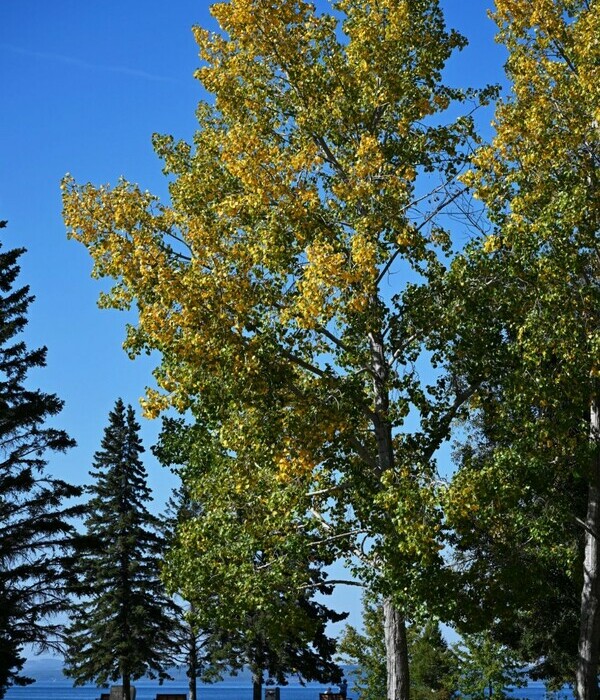Learn how to keep Sylvan Lake free from invasive species. Invasive species damage our community by:
- Outcompeting native plants and animals
- Destroying habitat
- Damaging tourism industries like lake fishing
Stormwater is not treated and flows into Sylvan Lake, Cygnet Lake and Cygnet Creek. Pets abandoned here end up in the lake.
Goldfish outcompete our native fish, cost taxpayers extra money, and damage our fishing tourism industry. Invasive fish harm our community by:
- Reproducing quickly, much faster than native fish
- Produce 500 - 1,000 eggs, often multiple times a summer
- Living for up to 30 - 40 years
- Passing diseases to native fish
- Eating native fish eggs, fish larvae, and aquatic plants
- Stirring up dirt while feeding, reducing the amount of sunlight to underwater plants. This leads to habitat loss for native species
- Requiring expensive tax funded clean ups to remove gold fish and their eggs
What if you don't want your pet anymore?
Don’t:
- Flush the fish down the toilet, alive or dead. It can still spread disease to other fish
- Release it into the wild
Do:
- Rehome your pet
- Take it back to the pet store
- Offer the pet for free by word of mouth or social media
- As a last resort, contact your local SPCA or pet rescue association
What should I do if I see a goldfish in the stormwater system or the lake?
- Take a picture if possible and note the location
- Call Environmental Services, 403 887 2800
Zebra and Quagga mussels can destroy our lake. They can contaminate aquarium plants, boats, and fishing gear.
Prevent zebra and quagga mussels from growing in Sylvan Lake:
- Visit the Government of Alberta mussels page
- Always clean, drain, and dry your boat after usage to stop aquatic hitchhikers.
- Report invasive species: 1 855 366 BOAT (2628)
Invasive weeds
Noxious weeds can appear as innocent domesticated flowers. Learn to identify common invasive weeds found in Sylvan Lake, so you can remove and dispose of them to slow spreading.
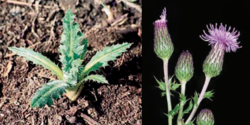
An aggressive perennial that spreads primarily with an extensive creeping root system. Infestations can impact wildlife by reducing food and access/nesting cover for waterfowl. Canada Thistle, native to Europe, does not tolerate waterlogged soil or complete shade.
Identification
- Stems are grooved, upright, hollow, and woody, branching near the top; they can grow up to 1.5 M tall;
- Leaves are lance-shaped, dark green, shiny on the surface, and occur alternately - slightly clasping the stem. Lower leaves are largest and decrease in size up-ward along the stems. Leaf edges can vary from smooth with no spines, to irregularly lobed with sharp spines;
- Flowers form at the ends of the stems in clusters. The flower head is urn-shaped and spineless. The colour of the flower may vary from purple, pink, or white.
Prevention and control
Maintain a healthy plant cover to prevent. Most of the biomass of Canada Thistle is below ground; therefore killing the roots is the only effective control method, as removal of the stems only, stimulates regrowth.
*Sourced from Alberta Invasive Species Council | abinvasives.ca
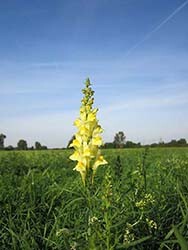
Brought from Europe as an ornamental plant, Common toadflax is a serious problem all over North America. Yellow Toadflax chokes out native plants and grasses, damaging gardens, parks, rangelands, and even mountain meadows. It can reduce crop yield and lead to soil erosion, and is toxic to livestock.
Identification
-
Often several hairless stems forming dense patches
-
Leaves are linear, narrowed at both ends, hairless, numerous and attached directly to the stem
-
Snapdragon-like flowers that are bright yellow with a yellow to orange throat
-
Often confused with buffalo/golden bean and Dalmatian toadflax. Also confused with Leafy spurge before flowering, but toadflax stems do not contain the milky latex that spurge does
- This perennial plant makes seed, but reproduction is primarily by sprouting from its extensive, creeping root system
Prevention and control
Once present, it establishes dense patches that are extremely difficult to control, let alone eradicate. Multiple control methods and several years of commitment provide the best success.
- Several herbicides are effective at controlling at Toadflax at differing stages. Please contact a yardcare/landscape professional for safe application practices.
- Thorough hand-pulling across 5 -6 years can be effective in soft soils where the roots can be removed easily. Repetition is required to deplete the seed bank and all root pieces. Mowing can assist by starving the roots. However, seeds that remain in the soil may continue to germinate for 10 to 15 years.
*Sourced from Alberta Invasive Species Council | abinvasives.ca
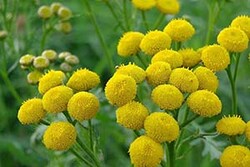
Introduced to Canada in the 1600's Common Tansy is an aromatic perennial with a history of use for medicinal purposes. The plants are toxic to both humans and livestock if consumed in large amounts.
Because of its history with alternative medicinal use, Common Tansy is often still found in plant nurseries, or from herbal remedy suppliers. Do not purchase or grow Common Tansy.
Identification
- Stems are branched and upright, often purple-ish. Many stems per plant;
- Leaves alternate along the stems, and are divided into numerous narrow, individual leaflets with toothed edges;
- Flowers are yellow, numberous, and botton-like, occuring in dense, flat-topped clusters at the tops of the stems.
Prevention and control
Cultivation is not an option as plants can re-grow from severed roots. Regular mowing reduces seed production, but repeated to eliminate regrowth. The most effective control method combines mowing/hand cutting, with chemical control while encouraging competition from native vegetation.
*Sourced from Alberta Invasive Species Council | abinvasives.ca
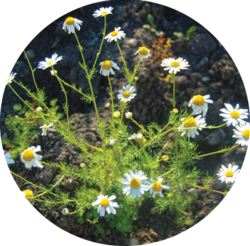
Scentless Chamomile and Oxeye Daisy are both classified as noxious weeds in the Alberta Weed Act and need to be controlled. Meanwhile, the Shasta daisy is a common garden feature, it is a domesticated plant and is not classified as a weed, but is often confused with Oxeye Daisy.
Oxeye Daisy is a very attractive common garden flower - often found in wildflower seed, but create problems when expanding beyond the garden - reeking havoc on biodiversity, and decreasing forage for wildlife, and livestock.
- Oxeye can infest the grass and in no time, take over the yard, or surrounding areas and ecosystems;
- An individual Oxeye Daisy plant can produce over 500 flat, black seeds that are viable in the soil for two to three years or more;
- Seeds have no dormancy requirement and are viable upon dispersal.
We strongly recommend people to pull these plants out of their yards, bag them, and replace with another white flower or a similar flower. If everybody does their part, this will help to create a healthy ecosystem, and biodiversity.
Identification | Scentless Chamomile
- The leaves on Scentless Chamomile are very finely divided, fern like or fennel-like looking;
- Flower heads are 2 - 3 cm in diameter.
Identification | Oxeye Daisy
- Oxeye Daisies resemble typical daisies, including the popular and non invasive Shasta Daisy;
- Flower heads are approximately 5 cm in diameter, and smaller than Shasta Daisies;
- The yellow centre is surrounded by 20 to 30 radiating petals with tips that are slighly notched;
- Leaves are jagged (moreso than Shastas), stalked, coarsely divided, and upper leavers are narrower (Shasta leaves are more spoon-shaped/rounded);
- Stems are hairless and rise up to 1 metre from a shallow yet creeping root system (Shasta stems are often taller).
Prevention and control
- Avoid purchasing/planting plants or seed packages labelled as Oxeye Daisy or Leucanthemum Vulgare;
- Deadhead any flowers;
- Remove all plant parts (ensure removal of entire root system), and place in a clear plastic bag, left in the sun to kill the seed - once roasted, keep bagged and dispose of;
- Avoid composting;
- Minimize soil disturbance;
- Repeated mowing prevents seed production, but also can stimulate re-sprouting of stems. Hand-pulling or digging before flowering is effective, but it is important to remove as much of the fibrous roots and rhizomes as possible. Repeated efforts will be required – both throughout the growing season and in subsequent years;
- Several herbicides are effective at controlling ox-eye daisy when applied to growing plants up to the flowering stage. Please contact a yardcare/landscape professional for safe application practices.
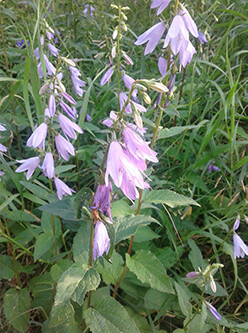
Creeping Bellflower is a perennial invader from Europe. Commonly found in flower beds and gardens. This weed can reproduce by both seed and creeping rhizomes and the roots are known to grow through lawns, beneath fences and underneath sidewalks. It grows well in a variety of soil types and light conditions and is somewhat drought tolerant.
Identification
- Erect stems, often purplish, smooth to hairy
- Grows to 1 meter tall or greater
- Leaves are alternately arranged on the stem, heart-shaped and coarsely toothed on the edges
- Flowers develop mainly along one side of the stem. They are light purple, have five connected petals and drooping in orientation
- Seeds are small, light brown and have wings. Numerous seeds are contained in a single round capsule
Prevention and control
- Hand-pulling or cutting and bagging flower spikes pre-bloom can be an option for preventing seed production. However, the plant will re-sprout from its creeping root system
- Digging out as much of the roots system as possible can be successful, but will require several years’ effort
*Sourced from Alberta Invasive Species Council | abinvasives.ca
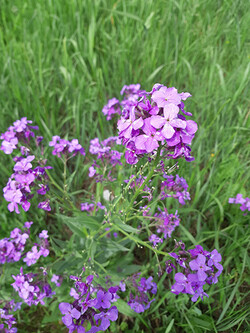
Dame's Rocket’s flowers are an invasive species that is often present in wildflower mixes. This perennial is a prolific seed producer, with up to 20,000 seeds per plant. It can out-compete native vegetation.
Identification
- The bloom is similar to lilac flowers, with four petals ranging in colour from purple to pink to white
- It's easy to miss because Dame's Rocket and lilac bushes are both fragrant and tend to come into bloom at the same time
- Hesperis matronalis (Aka Dames violet, sweet rocket)
Prevention and control
- Dames' rocket is often a contaminant of wildflower seed mixes – do not purchase seed mixes that do not list the Latin names of the contents
-
Hand pull as the roots come out easily from moist soils or dig out the plant and root
-
Plant density may increase the year following control work due to disturbance, but repeated removal will exhaust the
seed bank
*Sourced from Alberta Invasive Species Council | abinvasives.ca
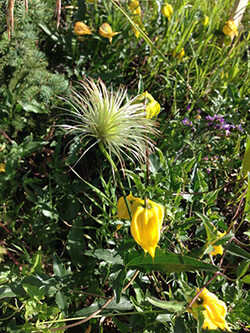
Yellow Clematis is an invasive species that is often sold as an ornamental plant. It spreads by seed and vegetatively from stem pieces.
Identification
- Grows quickly along the ground or climbs and covers other shrubs/trees, fences and trellisses
- There are several stems per plant, that can grow 3 - 4 metres long
-
Flowers are lemon-yellow with four petals, and appear mid-summer through late fall. Flowers are bell-shaped at first and then flatten as the petals spread. Seeds are oval with silky tails about 5-6 cm long.
- Clematis tangutica (Aka Golden Clematis, Golden Tiara, Virgins-Bower, Radar Love, Helios)
Prevention and control
-
Yellow clematis is distributed mainly through the nursery trade, and then spreads far beyond the gardens and flowerbeds via its abundant, wind dispersed seed. Do not purchase plants or seeds labeled with any of the
names listed above - Pull repeatedly before the seeds appear
*Sourced from Alberta Invasive Species Council | abinvasives.ca
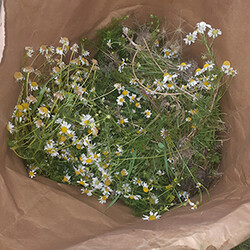
Fall is a great time to control the invasive weeds you’ve been struggling with all summer. Even a little effort now can have a much greater impact next growing season.
Lawn Care
With the cooler fall season temperatures coming in, our burnt-out grass finally has a chance to recover from the heat stress of summer.
- Encourage good grass competition during this time to help choke out any lingering weeds
- Fertilize, aerate, top dress, reseed, and use proper mowing height to help your lawn choke weeds out
- Your grass benefits from any activity that can help it build up a healthy root reserve of nutrients to last through the winter
Proper Disposal of Weeds
- Properly dispose of yard waste as you deadhead, prune, or remove built-up dead or dying material
- Be mindful of how and where you transport weed flowers or seed heads, diseased branches and leaves, or just general plant material
- Many times, weeds will show up in the community yard waste pile and spread out from there, causing problems for many others. Please:
- Don’t compost weed flowers and seeds or put them in your yard and kitchen waste container
- Bag them and place them in your garbage bin
Herbicide
Fall herbicide application can be effective for resolving perennial weed concerns before they become a problem next growing season.
- During the fall, after seed production, invasive plant’s resources (including any herbicides) are being diverted down to the root to store up energy reserves to over-winter
- This greatly increases the efficiency of the herbicide this time of year
- Carefully follow all label directions when using herbicides

